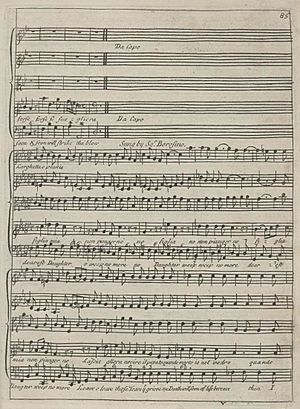Aria facts for kids

An aria is a special kind of song for a single singer. You usually hear arias in an opera, which is a play where the story is told mostly through singing. The word "aria" comes from Italian and means "air" or "tune." It became popular in the 1700s.
Arias often use only a few words, but they stretch them out with beautiful, flowing melodies. Sometimes, the singer holds a single syllable over many notes, which is called a melisma. Arias also often repeat musical ideas. Usually, a full orchestra plays along with the singer. However, in some older operas, like Purcell's Dido and Aeneas, the singer might only be joined by a few instruments playing the continuo (a bass line and chords).
Contents
What is an Aria in Opera?
In operas from the Baroque period (roughly 1600s to mid-1700s), music was mostly divided into two parts: recitative and aria.
Recitative: Telling the Story
Recitative is like musical talking. The word "recitative" means "to recite" or "to tell." In these parts, the singer would sing quickly, almost as if they were speaking. This helped to move the story along. The singer was usually only joined by a few instruments, like a harpsichord, playing simple chords.
Aria: Expressing Feelings
After a recitative explained a new part of the story, an aria would follow. The aria was where the singer could truly express their deep feelings about what was happening. Arias were much more musical and tuneful than recitatives. They often had a special structure called "ABA" form or "Da Capo" form.
Da Capo Form Explained
In Da Capo form, there was a main section (A), then a different middle section (B), and then the main section (A) was repeated. "Da Capo" is an Italian phrase meaning "back to the beginning." When the main section was repeated, singers often added their own fancy musical decorations and extra notes. This was a chance for them to show off their amazing singing skills!
Where Else Can You Find Arias?
The word "aria" isn't just for opera. You can also find arias in other types of musical works, like cantatas. A cantata is a piece of music for voices and instruments, often telling a story or expressing a theme. Sometimes, even pieces written only for instruments are called "arias." These instrumental arias are often a main tune followed by many different versions or "variations" of that tune. A famous example is Handel's "Air with Variations" for harpsichord.
How Arias Changed Over Time
By the 1800s, the clear difference between recitative and aria in opera started to fade away. Composers like Richard Wagner wanted their operas to flow more smoothly, without clear stops and starts. He didn't want the audience to clap in the middle of a scene. Instead, he wanted the music to develop continuously, like a long, unfolding story, without breaking into separate songs.
Images for kids
See also
 In Spanish: Aria para niños
In Spanish: Aria para niños



